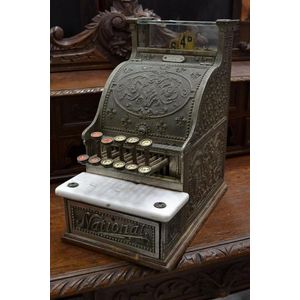Victorian Ebonised Overmantel with Bevelled Mirrors and Hand-painted Decor
A Victorian aesthetic movement overmantel multiple bevelled mirrors and shelves, ebonised paint finish with gilt embellishment, hand painted decoration of birds and florals. 130 x 145 cm.
You must be a subscriber, and be logged in to view price and dealer details.
Subscribe Now to view actual auction price for this item
When you subscribe, you have the option of setting the currency in which to display prices to $Au, $US, $NZ or Stg.
This item has been sold, and the description, image and price are for reference purposes only.
- Ebonised - Timber that has been stained or lacquered black in imitation of ebony. The process has been used since the Renaissance, but is most commonly found in late 19th century furniture, sometimes gilded and turned in imitation of bamboo. Furniture with an ebonised finish is not currently in vogue, and this is reflected in the price for such pieces.
- Victorian Period - The Victorian period of furniture and decorative arts design covers the reign of Queen Victoria from 1837 to 1901. There was not one dominant style of furniture in the Victorian period. Designers used and modified many historical styles such as Gothic, Tudor, Elizabethan, English Rococo, Neoclassical and others, although use of some styles, such as English Rococo and Gothic tended to dominate the furniture manufacture of the period.
The Victorian period was preceded by the Regency and William IV periods, and followed by the Edwardian period, named for Edward VII (1841 ? 1910) who was King of the United Kingdom and the British Dominions and Emperor of India for the brief period from 1901 until his death in 1910. - Bevel / Chamfer - In furniture making, a chamfered corner refers to a technique used to create a smooth, angled edge on the corner of a piece of furniture. This is typically done by cutting away a small portion of the corner at an angle, typically 45 degrees, creating a diagonal edge, rather than a sharp 90-degree angle. This technique can be used on various parts of a piece of furniture such as table legs, drawer fronts, or door frames. Chamfering can add visual interest to a piece and can help to soften the overall look of a piece of furniture. It is often used in conjunction with other techniques, such as rounding edges or using contrasting wood species to create a more elegant, sophisticated look. Chamfering is a simple way to add a touch of elegance to a piece of furniture and it is a common technique used by furniture makers.
This item has been included into following indexes:
- furniture, period or style - Aesthetic movement 74
-
mirrors, wall, period, age or style
- overmantle 793
- Victorian 321
Visually similar items

Antique French painted Henri II hall stand, with unusual brass rails and hooks, fitted with a central drawer, 210 cm high
Sold by
in
for
You can display prices in $Au, $US, $NZ or Stg.

Pair of antique French walnut easy arm chairs (2)
Sold by
in
for
You can display prices in $Au, $US, $NZ or Stg.

Small antique National cash register, no 216, approx 42 cm high, 24 cm wide, 39 cm deep
Sold by
in
for
You can display prices in $Au, $US, $NZ or Stg.

Indian painted box, 49 cm high, 106 cm wide
Sold by
in
for
You can display prices in $Au, $US, $NZ or Stg.
